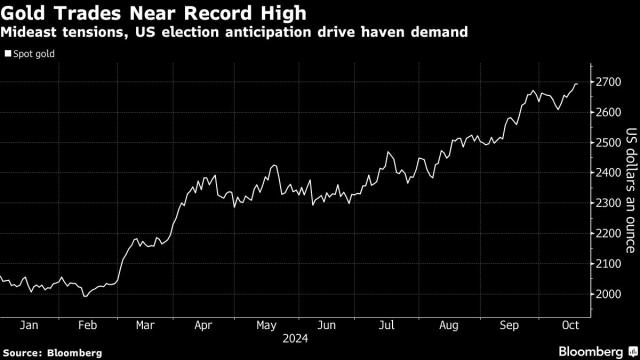
Gold prices reach an all-time high of $2,700 per ounce as geopolitical risks in the Middle East and uncertainty around the US election drive investors toward safe-haven assets.
Introduction: Gold Prices Reach Record Highs
Gold prices have soared past $2,700 per ounce, marking a historical first, as investors flock to safe-haven assets. Geopolitical unrest and the looming U.S. elections are amplifying market volatility, driving the surge in gold prices. This milestone highlights growing concerns over global stability and investor anxiety about the future.
Geopolitical Tensions Boost Gold Demand
One of the primary drivers behind the surge in gold prices is the escalating conflict in the Middle East. Israel’s announcement of the death of Yahya Sinwar, a key Hamas leader, has intensified tensions in the region. Prime Minister Benjamin Netanyahu reaffirmed Israel’s commitment to fight until all hostages are freed, further raising concerns.
In times of geopolitical conflict, investors traditionally turn to gold as a safe-haven asset. With no end to these tensions in sight, investors are moving quickly to protect their portfolios. For more detailed insights into how geopolitical crises impact gold, visit Bloomberg’s coverage.
Economic Concerns and Election Worries Add to Market Volatility
Beyond the geopolitical turmoil, the upcoming U.S. election on November 5 has added another layer of uncertainty. This election is shaping up to be one of the most unpredictable in recent history, pushing many investors to hedge with gold investments. According to Christopher Wong, an FX strategist at Oversea-Chinese Banking Corp., the fluid nature of election dynamics is driving some to take long positions in gold as a hedge against potential market shocks.
If you’re interested in how elections can impact the price of gold, check out this comprehensive report.
The Dollar’s Influence on Gold Prices
Gold’s rise is also being influenced by the performance of the U.S. dollar. The Bloomberg Dollar Spot Index recently dropped by 0.1%, breaking a four-day rally. This decline makes gold more affordable for international buyers, as it is priced in U.S. dollars. Despite stronger-than-expected retail sales data and a drop in jobless claims, the geopolitical and economic concerns are outweighing these positive indicators, further boosting gold prices.
For more information on how currency fluctuations affect gold prices, read this detailed article.
Central Bank Buying Remains Strong for Gold
A key pillar of support for the gold market has been the continued purchasing by central banks. This long-term buying trend remains strong, helping to bolster the metal’s price. Western investors, who had largely stayed out of the market during the first half of the year, are now returning in response to the Federal Reserve’s more dovish monetary policy.
At the London Bullion Market Association’s recent gathering, experts projected gold prices could rise to $2,917 per ounce by late 2025. This reflects growing optimism in the long-term outlook for gold as both a store of value and a key investment during uncertain times.
For a broader look at how central banks influence gold, explore this in-depth analysis.
Gold’s Future Outlook: Investor Confidence Remains Strong
With gold up over 30% in 2024, it remains one of the top-performing commodities globally. Investors are turning to gold amid escalating geopolitical tensions and looming economic uncertainties. As central banks continue their buying spree and the U.S. Federal Reserve maintains a dovish stance, gold prices are expected to remain strong in the near future.
Looking ahead, traders, refiners, and miners attending the London Bullion Market Association gathering remain bullish on gold’s future. With market predictions forecasting a rise to nearly $3,000 per ounce by the end of 2025, the outlook remains highly positive. This continued growth could cement gold’s position as one of the safest and most profitable assets for global investors.
